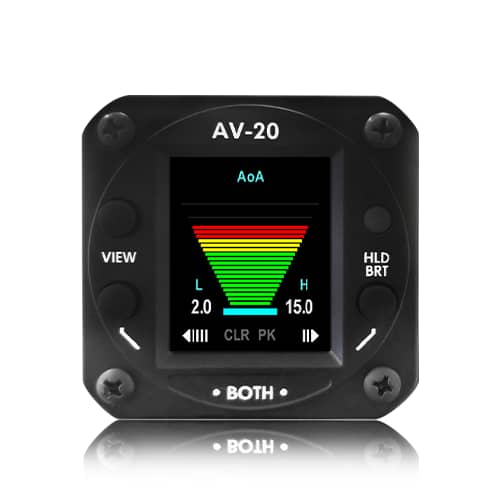Support
AV-20-S
Multi-Function 2 inch Digital Display | FAA Certified

Documentation & Downloads
| Document | Revision | Release Date |
|---|---|---|
| NORSEE Approval [PDF] | Rev E | 09/03/2024 |
| Install Manual [PDF] | Rev G | 08/14/2024 |
| Pilot Guide [PDF] | Rev F | 08/14/2024 |
Frequently Asked Questions
Please review the AV-20-S frequently asked questions prior to submitting a support ticket or placing a phone call.
Included are the AV-20-S with internal backup battery and two 1/4″ quick connect fittings, mounting screws, a d-subminiature connector, backshell, and pins.
An OAT probe is NOT included and must be purchased separately. The AV-20-S is compatible with the industry-standard Davtron Analog probe, available through common component suppliers. (If the OAT probe is not connected, OAT, DALT and TAS will not be displayed.)
Yes and no. During the majority of flight conditions, they are equivalent. However, during conditions where the aircraft is moving through a mass of air that has a vertical component, the behavior is slightly different.
As vertical updrafts are rarely of concern, the scenario to look at is the downdraft during final approach. In this environment, the aircraft will sink at a rate that is not consistent with the aircraft pitch. As the algorithm utilized compares the aircraft pitch to the actual flight path through the air, this will result in an artificial positive AoA (see diagram).
A downdraft that forces a sink rate of -1000 FPM will effectively increase the current AoA by approximately 5.6 degrees (this is speed dependent).
In effect, this makes the AoA thresholds more sensitive and an alert will be generated earlier than normal – but that’s a good thing in this scenario.
If a down-draft of this magnitude is experienced, the pilot action is to add power; Similarly, if AoA exceeds the configured limit, the pilot action is also to add power. As the pilot actions are identical for both scenarios, it can be argued that the source of unexpected altitude loss (downdraft or a wing losing lift) is irrelevant. Add power.
Interestingly, if taken to the extreme, the probeless AoA system actually starts to behave like a wind-shear alerter and any downdraft that is sufficient to cause excessive pitch vs flight path angle will generate an alert – it’s effectively a sink rate alert at that point.
In a probed system, as the probe is only measuring ambient air angle and loss of altitude is not measured, this arguably advantageous behavior is not available.
Angle of attack is determined by comparing aircraft pitch to the actual flight path angle through the air. This is equivalent to the angle at which the wing is intercepting the body of air surrounding the aircraft – exactly the same as a probe based AoA system. Pitch is determined by a precision internal AHRS, and flight path angle is determined by a precision ADC (airspeed and vertical speed). The resulting angle is then augmented with G-Load, as determined by internal acceleration sensors.
For example, during a climb, if the pitch angle is 10 degrees up, and the aircrafts flight path through the air (forward airspeed and vertical speed) is also 10 degrees up, the equivalent AoA is 0 Degrees. However, if the flight path angle through the air is only 7 degrees, then the equivalent AoA is positive 3 degrees as the wing is no longer able to maintain full lift.
Therefore, no dedicated AoA probe is required – only internal inertial and pressure sensors (8 in total). Connection to the aircraft’s pitot static system is required.
Reference Sperry Patent #3,948,096 for additional implementation details.

